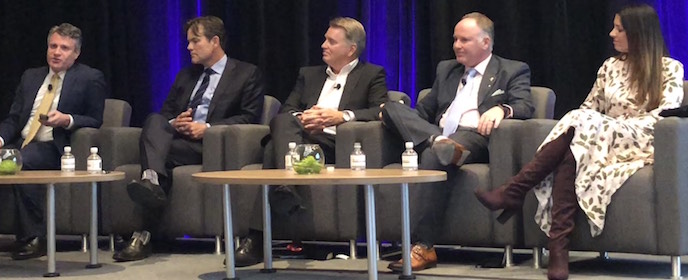While many senior living owners and operators stress investing in their buildings to keep occupancy high, investing in their workers is equally as important, if not more so.
That was among the top takeaways from a panel discussion at the National Investment Center for Seniors Housing & Care (NIC) fall conference in Chicago, which began in full Wednesday. The panel included leaders from Belmont Village Senior Living, Trilogy Health Services and The Springs Living.
It’s no secret that the senior living industry is in dire need of new workers, and that turnover is making the problem much worse. The industry will have to attract more than 1.2 million additional employees by 2025 — including filling 900,000 positions left vacant by turnover, according to 2016 projections from industry association Argentum. At the same time, the U.S. job market for employers is the tightest it’s been in decades, with job openings numbering seven million by the most recent counts.
Labor woes could be the new normal for the senior living industry, at least for the foreseeable future, according to Robert G. Kramer, the founder and current strategic advisor at the National Investment Center for Seniors Housing & Care (NIC).
“The labor challenges are not getting easier. This is not just a cyclical thing of a full-employment economy,” Kramer said from the audience during a question-and-answer portion of the panel. “We’re going to face an enormous shortage of caregivers in the future. And, at the same time when there will be increased demand.”
And the stakes couldn’t be higher right now. The difference between winners and losers in the future of the senior housing industry, Kramer said, is how well those companies can build their culture and workforce.
“It means huge opportunity for those who get it right,” Kramer said. “It means going out of business for those that don’t.”
Investing in people
While the panelists differed in their methods, they all agreed: in order to reduce turnover, senior living providers must be ready to reinvest in their culture and their workers.
And slashing turnover — one of the industry’s long-running labor bugbears — is of utmost importance, specifically because it could help providers bolster their bottom lines and drive up occupancy.
A recent white paper from Argentum and consultancy Great Place to Work shows just how substantial the savings can be: A hypothetical regional senior living operator with 1,500 employees and 20 communities stands to save $4.4 million annually and boost its occupancy by 2% just by increasing its employee retention by 10%.
It’s not just hypothetical providers, either. The Springs Living, a McMinnville, Oregon-based senior living operator with 17 communities spread across Oregon and Montana, found in an internal analysis that its communities with lower turnover rates had a higher occupancy rate and customer satisfaction overall.
“Our goal is to get our communities at 35% [turnover],” said Fee Stubblefield, founder and CEO of The Springs Living.
And yet, reducing turnover is often easier said than done. For The Springs, and many other senior living providers, it’s about finding good leaders to manage those communities.
“What we found was, where we have seasoned, tenured executive directors, they seem to be great at developing seasoned, tenured managers,” Stubblefield said. “And it has an impact on … the turnover.”
For Louisville, Kentucky-based Trilogy Health Services, a senior housing provider with 111 properties in Indiana, Kentucky, Ohio and Michigan, one of the most successful ways to boost employee retention has been to offer a student loan repayment program.
Under that program, Trilogy offers its workers $1,000 annually to pay down student loans. So far, the program has been a “home run in retention,” said Todd Schmiedeler, a senior vice president of foundation and workforce development at Trilogy.
“We’re 1.4 trillion dollars in student loan debt [in the U.S.],” Schmiedeler said. “It is one of the major stressors of your workforce going on every day.”
Trilogy also partners with the state of Indiana and takes part in its Next Level Jobs program. That program provides certain Indiana employers with reimbursements up to $50,000 annually to train their employees, according to panelist Blair Milo, Indiana’s secretary of career connections and talent.
And, Trilogy also offers to its employees robust scholarship programs for continued education, no matter where they reside within the organization. The company has an 82% retention rate among employees 12 months after they receive scholarship aid. And that’s among primarily front-line employees like certified nursing assistants (CNAs) and dietary aides, Schmiedeler said.
There’s another, more abstract way employers can keep workers from walking out the door — make them feel like they’re part of one big happy family, according to Doug Lessard, COO and executive vice president for Houston-based senior housing provider and developer Belmont Village. Currently, Belmont operates 28 senior living communities in seven states and Mexico City. It recently ranked No. 15 on the Best Workplaces for Aging Services 2018 list.
“You want to make sure you have engaged and happy employees,” Lessard said. “They like being part of a family.”
To help forge those familial ties, Belmont management strives to be flexible with time off requests, and celebrates important work anniversaries with fancy dinners and awards. The company also asks its employees: what ideas do you have? How can you help us innovate? Just last year, Belmont fielded 260 such ideas from employees, on topics such as improving operations or boosting resident satisfaction.
The end goal is to make employees feel valued and instill a sense of trust throughout the organization, Lessard noted.
“A high-trust environment is one where employees feel the leadership is credible,” he said. “They can relate to [leaders]. They feel like they’re doing their job. That they’re honest. Credible. And they feel like they’re being respected.”
Written by Tim Regan
Companies featured in this article:
Belmont Village Senior Living, The Springs Living, Trilogy Health Services


